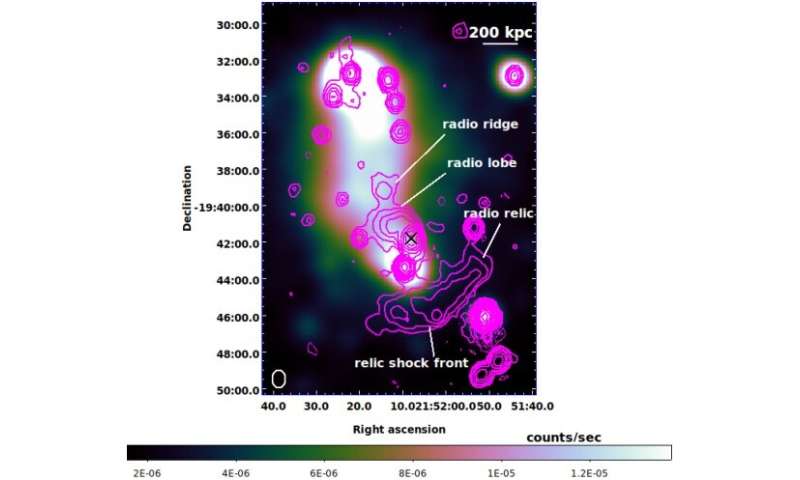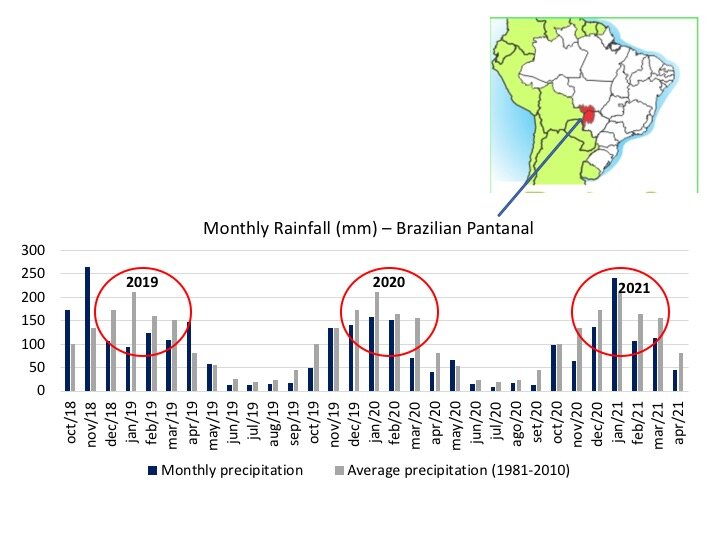#Radio relic discovered in a nearby galaxy cluster
“#Radio relic discovered in a nearby galaxy cluster”
September 15, 2020
report

Using the MeerKAT radio telescope in South Africa, an international team of astronomers has detected a radio relic in a nearby, low-mass, merging galaxy cluster designated A2384. The finding is reported in a research paper published September 6 on the arXiv pre-print repository.
Radio relics are diffuse, elongated radio sources of synchrotron origin. They occur in the form of spectacular single or double symmetric arcs at the peripheries of galaxy clusters. Astronomers are especially interested in searching for such sources in merging galaxy clusters, as the number of radio relics associated with merger shocks is still small.
At redshift of 0.092, A2384 is a nearby, low-mass (about 261 trillion solar masses), complex cluster of galaxies. It consists of two components, designated A2384(N) and A2384(S), showcasing a dense X-ray filament between them, estimated to be around 2.3 million light years long.
A group of astronomers led by Viral Parekh of the Rhodes University in Makhanda, South Africa, observed A2384 with MeerKAT in May 2019. They identified an extended radio source located at the edge of the galaxy cluster that turned out to be a single radio relic.
“In our MeerKAT images, we discovered an extended radio source at the bottom of the A2384(S) cluster,” the researchers wrote in the paper.
The newly found radio source is located perpendicular to the A2384 merger axis, extending from the south-east to the north-west. Its dimensions are approximately 2.7 by 0.86 million light years and the radio power of the source at 1.4 GHz was measured to be 387 million PW/Hz. The astronomers noted that the geometry, location and size of this source indicate that it is a radio relic associated with merger shock and the A2384 cluster.
Furthermore, the MeerKAT data reveal that the relic in A2384 is a very steep spectrum source, between 941-1454 MHz, with spectral index at a level of about -2.5. This, according to the authors of the paper, suggest the re-acceleration of the pre-relativistic electrons in the presence of the merger shock.
Trying to explain the origin of this radio relic, the astronomers assume that it is most likely the result of shock wave propagation during the passage of the low-mass A2384(S) cluster through the massive A2384(N) cluster. This may create a trail seen as a hot X-ray filament between the cluster’s two components.
“During the interaction of the clusters, sub-cluster A2384(S) has passed through A2384(N) and is likely to have removed a large amount of hot gas (and a number of galaxies) from both systems in the direction of the merger,” the researchers explained.
Besides the detection of the radio relic in A2384, Parekh’s team also found a candidate radio ridge in the cluster’s X-ray filament. The ridge is relatively small (about 590,000 by 420,000 light years) and the astronomers suppose that it could be a new class of radio source situated between the two components of A2384.
More information:
Parekh et al., MeerKAT’s discovery of a radio relic in the bimodal merging cluster A2384, arXiv:2009.02724 [astro-ph.GA] arxiv.org/abs/2009.02724
© 2020 Science X Network
Radio relic discovered in a nearby galaxy cluster (2020, September 15)
retrieved 15 September 2020
from https://phys.org/news/2020-09-radio-relic-nearby-galaxy-cluster.html
This document is subject to copyright. Apart from any fair dealing for the purpose of private study or research, no
part may be reproduced without the written permission. The content is provided for information purposes only.
if you want to watch Movies or Tv Shows go to Dizi.BuradaBiliyorum.Com for forums sites go to Forum.BuradaBiliyorum.Com
If you want to read more Like this articles, you can visit our Science category.


